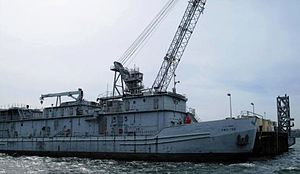The United States Navy, United States Coast Guard, and United States National Oceanic and Atmospheric Administration (NOAA) use a hull classification symbol to identify their ships by type and by individual ship within a type. The system is analogous to the pennant number system that the Royal Navy and other European and Commonwealth navies use.

The People's Liberation Army Navy, also known as the People's Navy, PLA Navy or simply Chinese Navy, is the naval warfare branch of the People's Liberation Army, the national armed forces of the People's Republic of China. It is composed of five sub-branches: the Surface Force, the Submarine Force, the Coastal Defense Force, the Marine Corps and the Naval Air Force, with a total strength of 240,000 personnel, including 15,000 marines and 26,000 naval aviation personnel, deployed among three theater command fleets, namely the North Sea, East Sea and South Sea Fleet.

HTMS Chakri Naruebet (911) is the flagship of the Royal Thai Navy (RTN), and Thailand's first and only aircraft carrier, although the RTN refers to her as an "Offshore Patrol Helicopter Carrier". Based on the Spanish Navy's Príncipe de Asturias design and constructed by Spanish shipbuilder Bazán, Chakri Naruebet was ordered in 1992, laid down in 1994, launched in 1996, and commissioned into the RTN in 1997. The ship is the smallest functioning aircraft carrier in the world.

The RIM-116 Rolling Airframe Missile (RAM) is a small, lightweight, infrared homing surface-to-air missile in use by the German, Japanese, Greek, Turkish, South Korean, Saudi Arabian, Egyptian, Mexican, UAE, and United States navies. It was originally intended and used primarily as a point-defense weapon against anti-ship missiles. As its name indicates, RAM rolls as it flies. The missile must roll during flight because the RF tracking system uses a two-antenna interferometer that can measure phase interference of the electromagnetic wave in one plane only. The rolling interferometer permits the antennas to look at all planes of incoming energy. In addition, because the missile rolls, only one pair of steering canards is required. As of 2005, it is the only U.S. Navy missile to operate in this manner.

The Republic of China Navy is the maritime branch of the Republic of China Armed Forces (ROCAF).
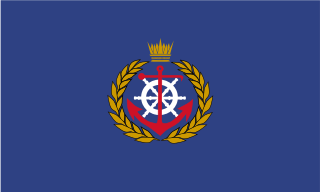
The Royal Bahraini Naval Force, also called the Royal Bahraini Navy, is the maritime branch of the Bahrain Defence Force. The RBNF consists of 700 personnel, 35 ships, and two helicopters. The fleet includes one frigate, the former U.S. Oliver Hazard Perry-classRBNS Sabha.

The Chamsuri class are patrol boats originally constructed for and operated by the Republic of Korea Navy. They first entered service in 1979, and they have since seen service with five other navies, of which the Philippine Navy is currently the largest import user. These boats were built by the Korea Tacoma, and Korea SB & Eng. Masan shipyards. In Korea, the Chamsuri-class boats are being retired and replaced by Gumdoksuri-class patrol vessels.
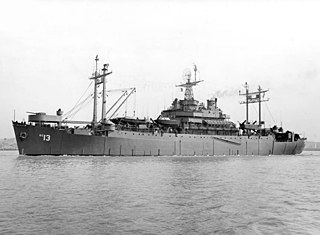
USS Panamint (AGC-13) was a Mount McKinley-class amphibious force command ship named after the Panamint Range of mountains in California. She was designed as an amphibious force flagship, a floating command post with advanced communications equipment and extensive combat information spaces to be used by the amphibious forces commander and landing force commander during large-scale operations.

Salamis was a partially constructed capital ship, referred to as either a dreadnought battleship or battlecruiser, that was ordered for the Greek Navy from the AG Vulcan shipyard in Hamburg, Germany, in 1912. She was ordered as part of a Greek naval rearmament program meant to modernize the fleet, in response to Ottoman naval expansion after the Greco-Turkish War of 1897. Salamis and several other battleships—none of which were delivered to either navy—represented the culmination of a naval arms race between the two countries that had significant effects on the First Balkan War and World War I.

A Service Squadron (ServRon) was a United States Navy squadron that supported fleet combat ships and US Navy Auxiliary ships. Service Squadrons were used by the US Navy from their inception in 1943 to as late as the early 1980s. At the time of their inception during the Second World War they allowed the US Navy to operate across the vast reaches of the Pacific Ocean for extended periods of time. Service Squadrons created temporary forward bases to allow the naval squadrons to spend less time in transit and more time in the area of combat. Ulithi, a small volcanic atoll in the central Pacific, is an example of a site converted for use as a forward base of supply. Service Squadrons essentially created a major naval base near the area of operation. With naval bases like, Naval Base Ulithi, to refit, repair and resupply, many ships were able to deploy and operate in the western Pacific for a year or more without returning to a major port facility. Among the vessels operating in service squadrons were tankers, Fleet oilers, refrigerator ships, ammunition ships, supply ships, floating docks and repair ships. They provided diesel, ordnance, aviation fuel, food stuffs and all other supplies. Equally important at places like Ulithi were the portable piers and floating dry docks which allowed many ships damaged by enemy action or Pacific storms to undergo repair without having to travel the thousands of miles back to a major US naval base. Ulithi was as far forward from the US naval base at San Francisco as the San Francisco base was from London, England. To have a fully functional major port in the middle of the Pacific was a significant aid to U.S. Navy operations.
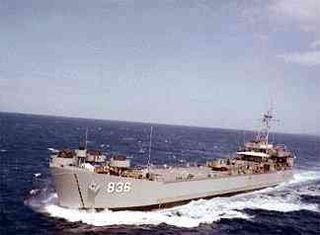
USS Holmes County (LST-836) was an LST-542-class tank landing ship built for the United States Navy during World War II. Named after counties in Florida, Mississippi, and Ohio, she was the only U.S. Naval vessel to bear the name.

USS Etamin (AK-93) was the Liberty ship (EC2) Isaac Babbitt constructed for the US Maritime Commission (MARCOM) in 1943, for World War II service at a cost of $959,509. After acquisition by the US Navy, the ship was named Etamin, after the brightest star in the constellation Draco and manned by a US Coast Guard crew. As a Crater-class cargo ship, she served the military in the Pacific Ocean by providing food and material until she was torpedoed and put out of service. After repairs, she served as a non-self-propelled floating warehouse for the rest of the war. The ship ended the war in the Philippines and was among fifteen hulls sold for scrap for a lump sum of $271,000.

The United States Navy (USN) is the maritime service branch of the United States Armed Forces and one of the eight uniformed services of the United States. It is the world's most powerful navy and the largest by tonnage, at 4.5 million tons in 2021 and in 2009 an estimated battle fleet tonnage that exceeded the next 13 navies combined. It has the world's largest aircraft carrier fleet, with 11 in service, 1 undergoing trials, two new carriers under construction, and six other carriers planned as of 2024. With 336,978 personnel on active duty and 101,583 in the Ready Reserve, the U.S. Navy is the third largest of the United States military service branches in terms of personnel. It has 299 deployable combat vessels and about 4,012 operational aircraft as of July 18, 2023.
USS Mark (AG-143), was built as the Aircraft Repair variant, Design 427, of the Army FS types as FS-214 for use by the United States Army. She was built at Higgins Industries, New Orleans, Louisiana, completed in December 1944. The ship was designed with the well deck covered to provide shop space for the work of repairing aircraft by an embarked Aircraft Maintenance Unit (Floating).

USS Santa Barbara (LCS-32) is an Independence-class littoral combat ship of the United States Navy. She is the 32nd ship of the type, and 16th of the class, which is inter-numbered with the Freedom-class littoral combat ships. With 35 LCSs now active or planned, the type is the Navy's second largest number of surface warfare ships in production, next only to its guided missile destroyers. She is the third US Navy ship to be named for the city of Santa Barbara, California.

USS Cleveland (LCS-31) is a Freedom-class littoral combat ship of the United States Navy. She is the fourth commissioned ship in naval service named after Cleveland, the second-largest city in Ohio.
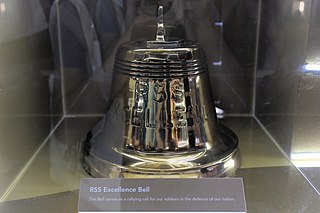
USS LST-629 originally was a United States Navy LST-542-class tank landing ship built during World War II and in commission from 1944 to 1946 and again in the late 1952. She was sold to the Republic of Singapore Navy and renamed RSS Excellence (L-202).
USS LST-579 originally was a United States Navy LST-542-class tank landing ship built during World War II and in commission from 1944 to 1946 and again in the late 1952. She was sold to the Republic of Singapore Navy and renamed RSS Intrepid (L-203).
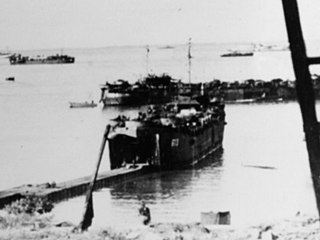
USS LST-613 originally was a United States Navy LST-542-class tank landing ship built during World War II and in commission from 1944 to 1946, and again in the late 1952. In 1976, she was sold to the Republic of Singapore Navy and renamed RSS Persistence (L-205).
